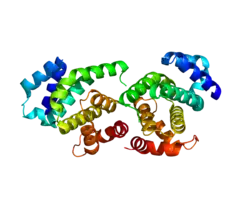EIF4G2
Eukaryotic translation initiation factor 4 gamma 2 (also called p97, NAT1, and DAP-5) is a protein that in humans is encoded by the EIF4G2 gene.[5][6]
Function
Translation initiation is mediated by specific recognition of the cap structure by eukaryotic translation initiation factor 4F (eIF4F), which is a cap binding protein complex that consists of three subunits: eIF4A, eIF4E and eIF4G. The protein encoded by the eIF4G2 gene shares similarity with the C-terminal region of eIF4G1 that contains the binding sites for eIF4A and eIF3. eIF4G2 additionally contains a binding site for eIF4E at the N-terminus. Unlike eIF4G1, which supports cap-dependent and independent translation, the eIF4G2 gene product functions as a general repressor of translation by forming translationally inactive complexes. In vitro and in vivo studies indicate that translation of this mRNA initiates exclusively at a non-AUG (GUG) codon. Alternatively spliced transcript variants encoding different isoforms of this gene have been described.[7]
References
- GRCh38: Ensembl release 89: ENSG00000110321 - Ensembl, May 2017
- GRCm38: Ensembl release 89: ENSMUSG00000005610 - Ensembl, May 2017
- "Human PubMed Reference:". National Center for Biotechnology Information, U.S. National Library of Medicine.
- "Mouse PubMed Reference:". National Center for Biotechnology Information, U.S. National Library of Medicine.
- Yamanaka S, Poksay KS, Arnold KS, Innerarity TL (March 1997). "A novel translational repressor mRNA is edited extensively in livers containing tumors caused by the transgene expression of the apoB mRNA-editing enzyme". Genes Dev. 11 (3): 321–33. doi:10.1101/gad.11.3.321. PMID 9030685.
- Levy-Strumpf N, Deiss LP, Berissi H, Kimchi A (March 1997). "DAP-5, a novel homolog of eukaryotic translation initiation factor 4G isolated as a putative modulator of gamma interferon-induced programmed cell death". Mol. Cell. Biol. 17 (3): 1615–25. doi:10.1128/mcb.17.3.1615. PMC 231887. PMID 9032289.
- "Entrez Gene: EIF4G2 eukaryotic translation initiation factor 4 gamma, 2".
- Gradi A, Imataka H, Svitkin YV, Rom E, Raught B, Morino S, Sonenberg N (January 1998). "A novel functional human eukaryotic translation initiation factor 4G". Mol. Cell. Biol. 18 (1): 334–42. doi:10.1128/mcb.18.1.334. PMC 121501. PMID 9418880.
- Henis-Korenblit S, Strumpf NL, Goldstaub D, Kimchi A (January 2000). "A novel form of DAP5 protein accumulates in apoptotic cells as a result of caspase cleavage and internal ribosome entry site-mediated translation". Mol. Cell. Biol. 20 (2): 496–506. doi:10.1128/MCB.20.2.496-506.2000. PMC 85113. PMID 10611228.
Further reading
- Maruyama K, Sugano S (1994). "Oligo-capping: a simple method to replace the cap structure of eukaryotic mRNAs with oligoribonucleotides". Gene. 138 (1–2): 171–4. doi:10.1016/0378-1119(94)90802-8. PMID 8125298.
- Shaughnessy JD, Jenkins NA, Copeland NG (1997). "cDNA cloning, expression analysis, and chromosomal localization of a gene with high homology to wheat eIF-(iso)4F and mammalian eIF-4G". Genomics. 39 (2): 192–7. doi:10.1006/geno.1996.4502. PMID 9027506.
- Imataka H, Olsen HS, Sonenberg N (1997). "A new translational regulator with homology to eukaryotic translation initiation factor 4G". EMBO J. 16 (4): 817–25. doi:10.1093/emboj/16.4.817. PMC 1169682. PMID 9049310.
- Imataka H, Sonenberg N (1997). "Human eukaryotic translation initiation factor 4G (eIF4G) possesses two separate and independent binding sites for eIF4A". Mol. Cell. Biol. 17 (12): 6940–7. doi:10.1128/mcb.17.12.6940. PMC 232551. PMID 9372926.
- Suzuki Y, Yoshitomo-Nakagawa K, Maruyama K, Suyama A, Sugano S (1997). "Construction and characterization of a full length-enriched and a 5'-end-enriched cDNA library". Gene. 200 (1–2): 149–56. doi:10.1016/S0378-1119(97)00411-3. PMID 9373149.
- Pyronnet S, Imataka H, Gingras AC, Fukunaga R, Hunter T, Sonenberg N (1999). "Human eukaryotic translation initiation factor 4G (eIF4G) recruits mnk1 to phosphorylate eIF4E". EMBO J. 18 (1): 270–9. doi:10.1093/emboj/18.1.270. PMC 1171121. PMID 9878069.
- Marcotrigiano J, Gingras AC, Sonenberg N, Burley SK (1999). "Cap-dependent translation initiation in eukaryotes is regulated by a molecular mimic of eIF4G". Mol. Cell. 3 (6): 707–16. doi:10.1016/S1097-2765(01)80003-4. PMID 10394359.
- Henis-Korenblit S, Strumpf NL, Goldstaub D, Kimchi A (2000). "A novel form of DAP5 protein accumulates in apoptotic cells as a result of caspase cleavage and internal ribosome entry site-mediated translation". Mol. Cell. Biol. 20 (2): 496–506. doi:10.1128/MCB.20.2.496-506.2000. PMC 85113. PMID 10611228.
- Marcotrigiano J, Lomakin IB, Sonenberg N, Pestova TV, Hellen CU, Burley SK (2001). "A conserved HEAT domain within eIF4G directs assembly of the translation initiation machinery". Mol. Cell. 7 (1): 193–203. doi:10.1016/S1097-2765(01)00167-8. PMID 11172724.
- Marissen WE, Gradi A, Sonenberg N, Lloyd RE (2000). "Cleavage of eukaryotic translation initiation factor 4GII correlates with translation inhibition during apoptosis". Cell Death Differ. 7 (12): 1234–43. doi:10.1038/sj.cdd.4400750. PMID 11175261.
- Asano K, Shalev A, Phan L, Nielsen K, Clayton J, Valásek L, Donahue TF, Hinnebusch AG (2001). "Multiple roles for the C-terminal domain of eIF5 in translation initiation complex assembly and GTPase activation". EMBO J. 20 (9): 2326–37. doi:10.1093/emboj/20.9.2326. PMC 125443. PMID 11331597.
- Pyronnet S, Dostie J, Sonenberg N (2001). "Suppression of cap-dependent translation in mitosis". Genes Dev. 15 (16): 2083–93. doi:10.1101/gad.889201. PMC 312759. PMID 11511540.
- Henis-Korenblit S, Shani G, Sines T, Marash L, Shohat G, Kimchi A (2002). "The caspase-cleaved DAP5 protein supports internal ribosome entry site-mediated translation of death proteins". Proc. Natl. Acad. Sci. U.S.A. 99 (8): 5400–5. doi:10.1073/pnas.082102499. PMC 122781. PMID 11943866.
- Perales C, Carrasco L, Ventoso I (2003). "Cleavage of eIF4G by HIV-1 protease: effects on translation". FEBS Lett. 533 (1–3): 89–94. doi:10.1016/S0014-5793(02)03764-X. PMID 12505164. S2CID 35982071.
- Gevaert K, Goethals M, Martens L, Van Damme J, Staes A, Thomas GR, Vandekerckhove J (2003). "Exploring proteomes and analyzing protein processing by mass spectrometric identification of sorted N-terminal peptides". Nat. Biotechnol. 21 (5): 566–9. doi:10.1038/nbt810. PMID 12665801. S2CID 23783563.
- Li Z, Hu CY, Mo BQ, Xu JD, Zhao Y (2003). "[Effect of beta-carotene on gene expression of breast cancer cells]". AI Zheng. 22 (4): 380–4. PMID 12703993.
- Qin H, Raught B, Sonenberg N, Goldstein EG, Edelman AM (2003). "Phosphorylation screening identifies translational initiation factor 4GII as an intracellular target of Ca(2+)/calmodulin-dependent protein kinase I". J. Biol. Chem. 278 (49): 48570–9. doi:10.1074/jbc.M308781200. PMID 14507913.




